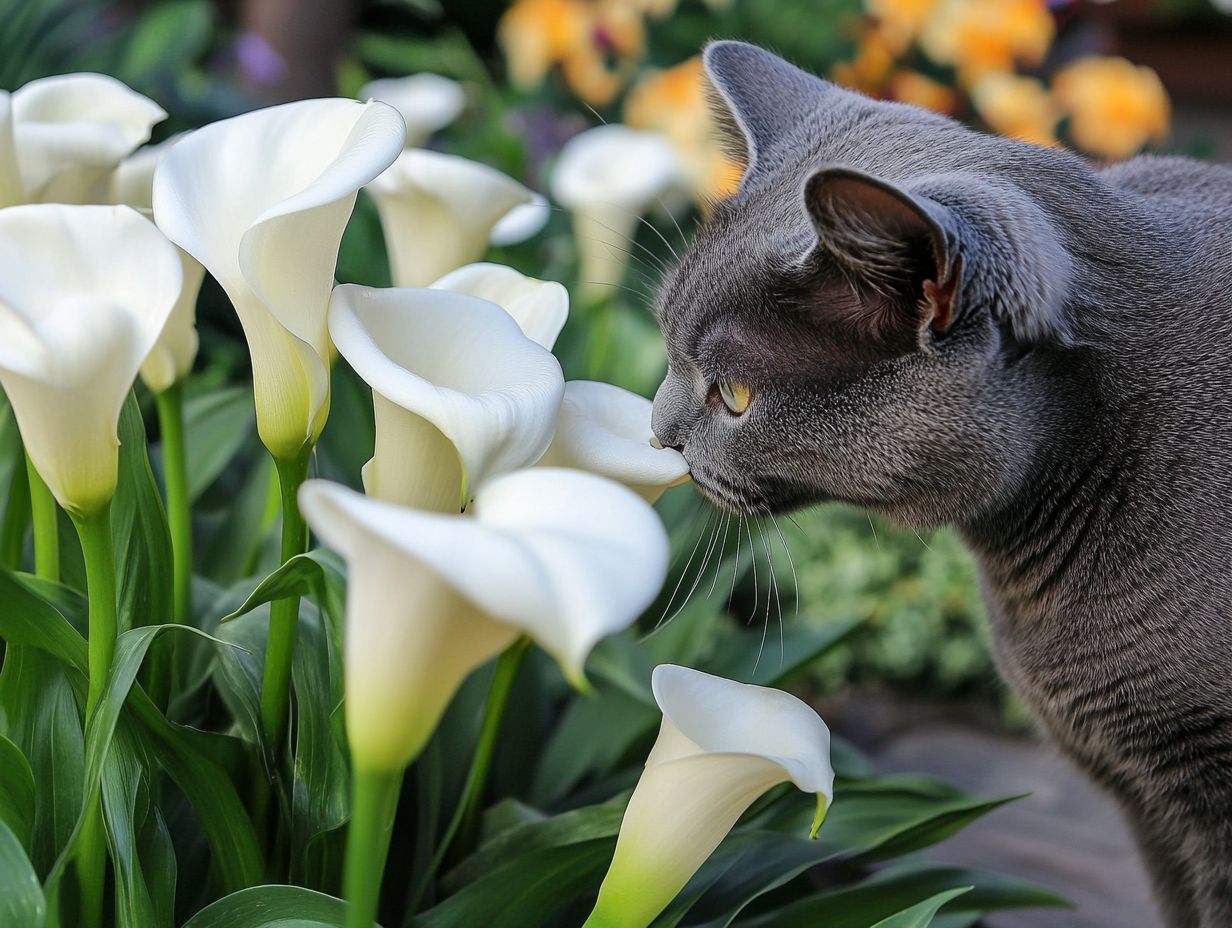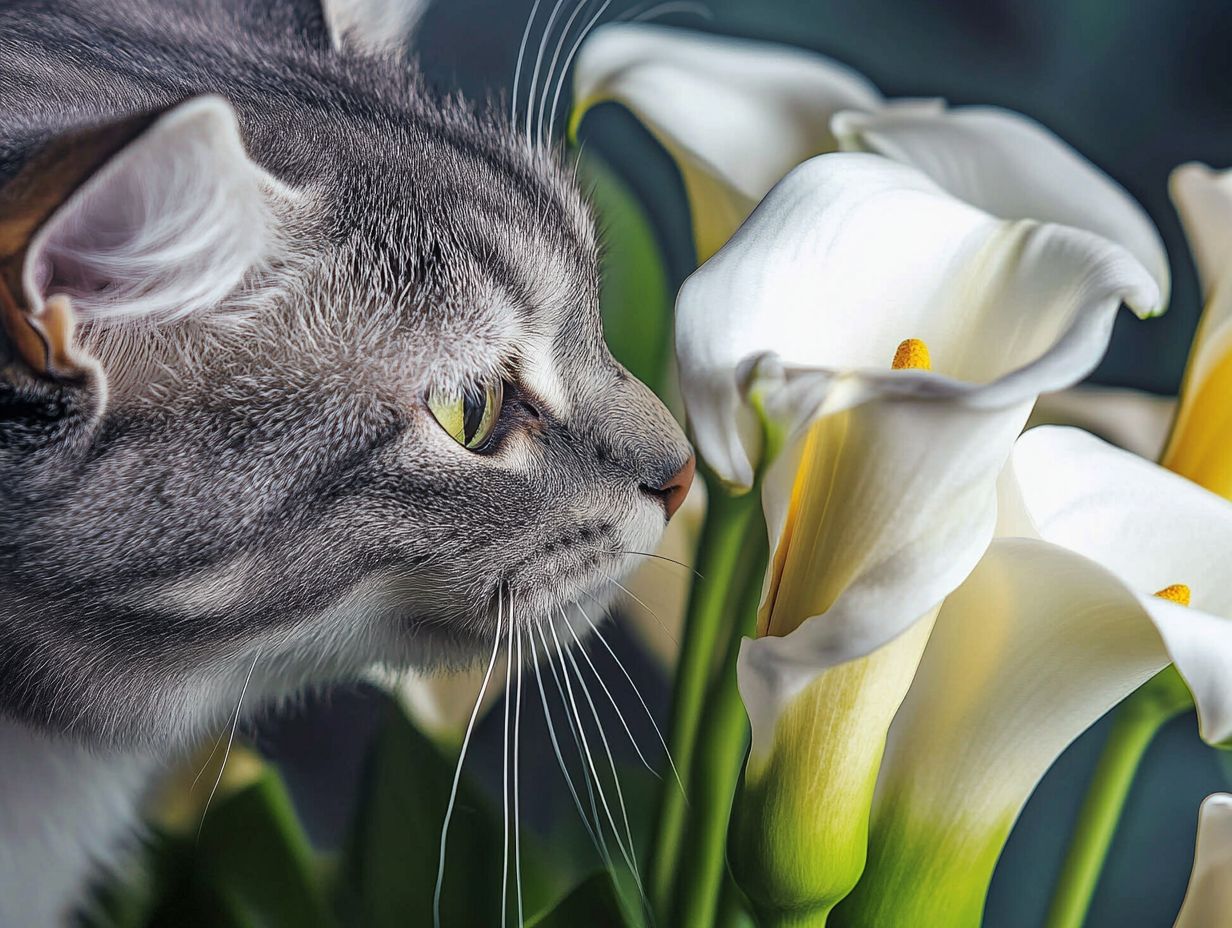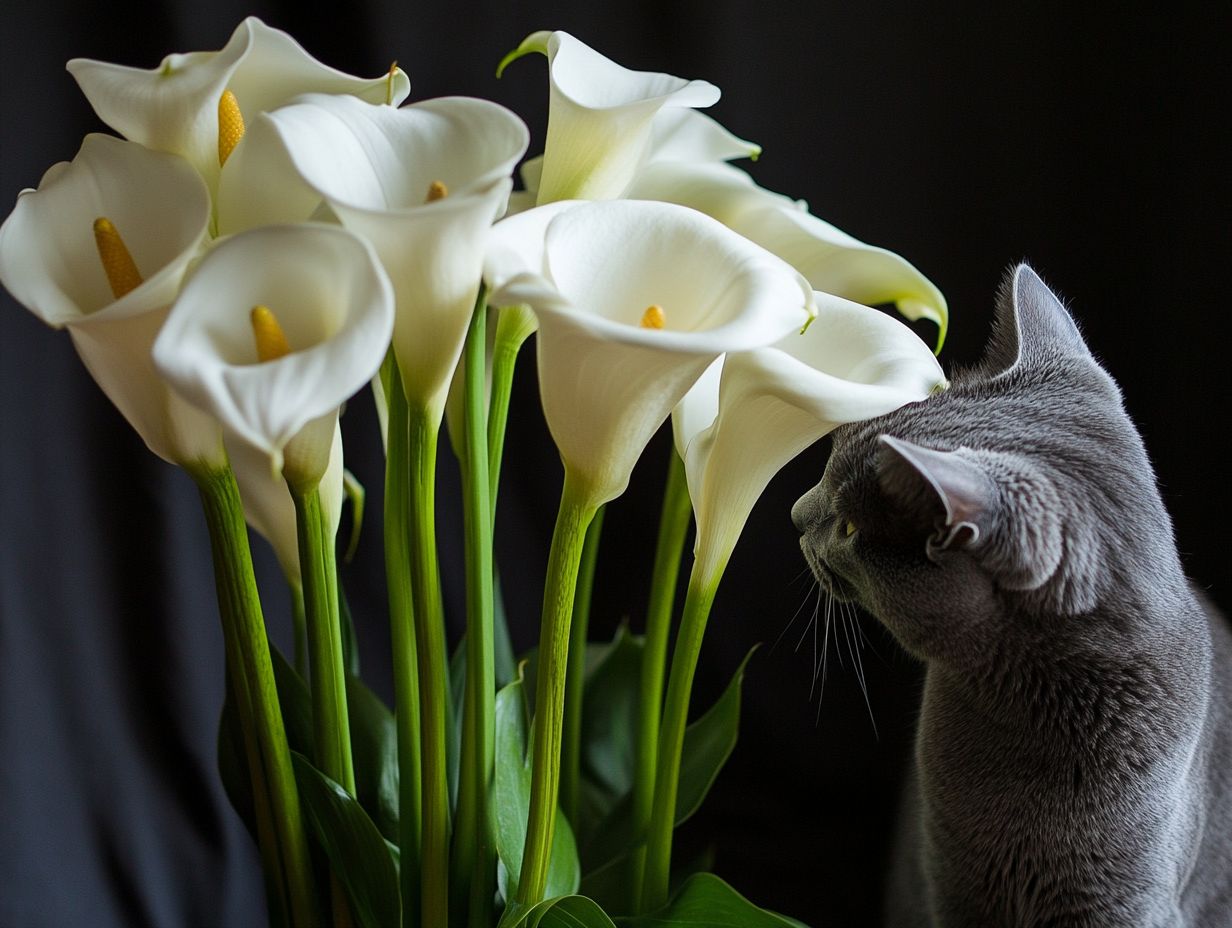Calla lilies are stunning flowers that can brighten any home, but they come with a hidden danger for cat owners as they are significantly toxic to cats. This toxicity rating indicates that even small amounts can lead to severe health issues.
These beautiful blooms contain toxic compounds, including calcium oxalate crystals, that can be harmful—and potentially fatal—to your feline friends. For more information, consult sources like the ASPCA Animal Poison Control or veterinary journals on toxic plants.
Explore the risks associated with calla lilies, what to do if your cat ingests them, and how to keep your pet safe. It’s essential to understand that while these flowers may appear harmless, they pose a serious risk.
Discover safe alternatives and learn about other plants to avoid, ensuring a harmonious home for both you and your cat.
Key Takeaways:

- Calla lilies are a popular flower that can be fatal to cats if ingested.
- The entire calla lily plant is toxic to cats, with the highest concentration of toxins in the bulb and leaves.
- If your cat ingests calla lilies, seek immediate veterinary care.
What Are Calla Lilies?
Calla lilies, scientifically known as Zantedeschia aethiopica, are trumpet-shaped flowers often found in gardens and floral arrangements. These elegant and beautiful plants are popular in various decorative settings; however, it is important to highlight their potential dangers to pets.
Many plant enthusiasts may be unaware that calla lilies contain calcium oxalate crystals, which can lead to severe health issues in pets, particularly in cats.
Are Calla Lilies Poisonous to Cats?
Yes, calla lilies are toxic to cats due to the presence of calcium oxalate crystals, which can lead to severe health issues if ingested. These lilies are regarded as significantly toxic, as even small parts of the plant can trigger a range of adverse reactions.
This underscores the importance of ensuring plant safety in homes with pets, as many plants toxic to cats often appear harmless.
What Parts of the Calla Lily are Toxic to Cats?
Every part of the calla lily—including the leaves, stems, and flowers—is toxic to cats. Symptoms may vary in severity:
- Mild: Drooling, mild oral irritation
- Moderate: Vomiting, diarrhea, difficulty swallowing
- Severe: Oral pain, throat swelling, potential kidney failure
Ingestion of the plant can result in symptoms such as mouth irritation, oral pain, and gastrointestinal distress. It is essential for pet owners to be aware of the safety of plants in their homes.
When a curious cat consumes any part of this plant, it may experience severe reactions. Pet owners should also be aware of the risks of plant ingestion and the need for immediate veterinary care.
It is crucial to monitor pets around household plants to prevent accidental ingestion. Removing harmful plants from both the home and yard creates a safer environment for beloved pets.
What Happens if a Cat Ingests Calla Lilies?
Calla lily toxicity in cats can lead to severe clinical symptoms, including gastrointestinal distress and oral irritation, which may necessitate veterinary intervention.
If your cat ingests calla lilies, follow these steps:
- Stay calm and assess your cat’s condition.
- Remove any remaining plant material from their mouth.
- Contact your veterinarian or the ASPCA Animal Poison Control immediately.
- Follow their instructions carefully.
Prompt emergency care is essential to ensure the best prognosis in such cases.
What Are the Symptoms of Calla Lily Poisoning in Cats?

Symptoms of calla lily poisoning in cats include:
- Oral pain
- Throat swelling
- Gastrointestinal distress (vomiting or diarrhea)
- Excessive drooling
- Difficulty swallowing
- Lethargy
Pet owners should be vigilant for these signs of toxicity and not hesitate to contact a veterinarian if any symptoms arise.
Prevention Tips
- Store potentially harmful plants out of reach.
- Consider safe plant alternatives like spider plants or Boston ferns.
- Educate family members about the risks of toxic plants.
Special Considerations
Kittens and cats with existing health conditions may be at an increased risk of severe reactions to calla lilies. Extra caution should be exercised to ensure their safety.
Disclaimer: This content is for informational purposes only and does not replace professional veterinary advice. Regularly review and update the content based on the latest veterinary research. For detailed studies, refer to sources like PubMed.
Last reviewed: October 2023
In severe cases, a cat may experience shock or difficulty breathing. It is important for cat owners to understand that the severity of these symptoms can vary; even mild symptoms can escalate quickly. This rapid progression can significantly impact how soon the cat receives veterinary care.
Therefore, if any of these symptoms are observed, prompt veterinary attention may be crucial for the cat’s survival.
Toxicity Information
Calla lilies are considered toxic to cats. All parts of the plant, including the leaves and flowers, contain calcium oxalate, which can cause serious health issues if ingested.
What Should You Do if Your Cat Ingests Calla Lilies?
If you suspect that your cat has ingested calla lilies, it is essential to contact a veterinarian or pet poison control immediately for guidance and potential treatment. The veterinarian may recommend bringing your cat in for a medical evaluation and emergency care, particularly if there are signs of mouth irritation, gastrointestinal upset, or other toxicity symptoms.
Be prepared for possible interventions, such as inducing vomiting or administering activated charcoal, as advised by the veterinarian. Knowing the contact numbers for local animal poison control resources can save valuable time and help ensure that an effective treatment plan is implemented swiftly.
First Aid and Treatment
- Identify the plant consumed—ensure it is calla lily.
- Contact your veterinarian or local pet poison control immediately.
- Provide as much information as possible, including the amount ingested and any symptoms observed.
- Follow the veterinarian’s instructions regarding potential interventions.
How Can You Prevent Your Cat from Ingesting Calla Lilies?
To prevent your cat from eating calla lilies, pet owners should focus on plant safety and careful future planning. It’s essential to keep toxic plants out of reach or replace them with non-toxic alternatives that do not pose a risk to your pet’s health.
By being proactive and informed about the dangers associated with certain plants, you can create a safer environment for your cat and reduce the likelihood of accidental ingestion.
What Are Some Safe Alternatives to Calla Lilies for Cat Owners?
Safe alternatives to calla lilies for cat owners include spider plants, Boston ferns, and parlor palms. These plants do not pose a toxicity risk, making them safe to have around pets. They provide similar ornamental benefits to a home while ensuring the safety of furry companions.
- Spider Plants
- Boston Ferns
- Parlor Palms
These plants not only enhance the visual appeal of a space but also improve air quality.
With careful selection of non-toxic varieties, pet owners can cultivate a harmonious atmosphere in which both cats and their owners can thrive.
Common Symptoms of Plant Poisoning in Cats
Symptoms of calla lily ingestion can be categorized by severity:
- Mild: Drooling, oral irritation, minor vomiting.
- Moderate: Gastrointestinal upset, vomiting, diarrhea, abdominal pain.
- Severe: Difficulty breathing, shock, and severe lethargy.
What Other Plants Are Toxic to Cats?
Along with calla lilies, several other plants are toxic to cats, making it essential for pet owners to be aware of the plants in their homes. Common toxic plants include true lilies, such as Lilium, which are particularly dangerous if ingested. Ensuring plant safety is crucial for cat safety.
What Are Some Common Misconceptions About Calla Lilies?
Many believe that all lilies are equally dangerous. However, while calla lilies are toxic, other types of lilies may have varying degrees of toxicity. It is important to educate oneself about individual plant risks. For example, peace lilies are mildly toxic, whereas true lilies can cause severe reactions.
Special Considerations
Kittens, senior cats, or cats with existing health conditions may face heightened risks when it comes to plant ingestion. Extra caution should be taken with these vulnerable groups.
Visual Aids

Infographics summarizing key points about calla lilies and their toxicity will assist in quick identification and understanding.
Prevention and Safety Measures
Keep toxic plants out of reach and consider safe alternatives. Regularly review which plants you have in your home to ensure they are non-toxic.
Emergency Contacts
If your cat shows symptoms of poisoning, report the case to the ASPCA Animal Poison Control at (888) 426-4435. Always keep this information readily available in case of emergencies.
Frequently Asked Questions
Can Calla Lilies Be Fatal to Cats?
Yes, calla lilies can be fatal to cats if ingested in large amounts.
What are the symptoms of calla lily poisoning in cats?
The most common symptoms include drooling, vomiting, difficulty swallowing, oral irritation, and gastrointestinal upset.
How much of a calla lily plant is toxic to cats?
Even a small amount of the plant can be toxic to cats.
What should I do if my cat has ingested a calla lily?
If you suspect your cat has ingested a calla lily, seek immediate veterinary care.
Are all types of lilies toxic to cats?
No, but all plants in the lily family, including calla lilies, Easter lilies, and peace lilies, are toxic.
How can I safely enjoy calla lilies without putting my cat at risk?
Keep them out of reach or consider using artificial lilies or non-toxic plants.
Last Updated: October 2023